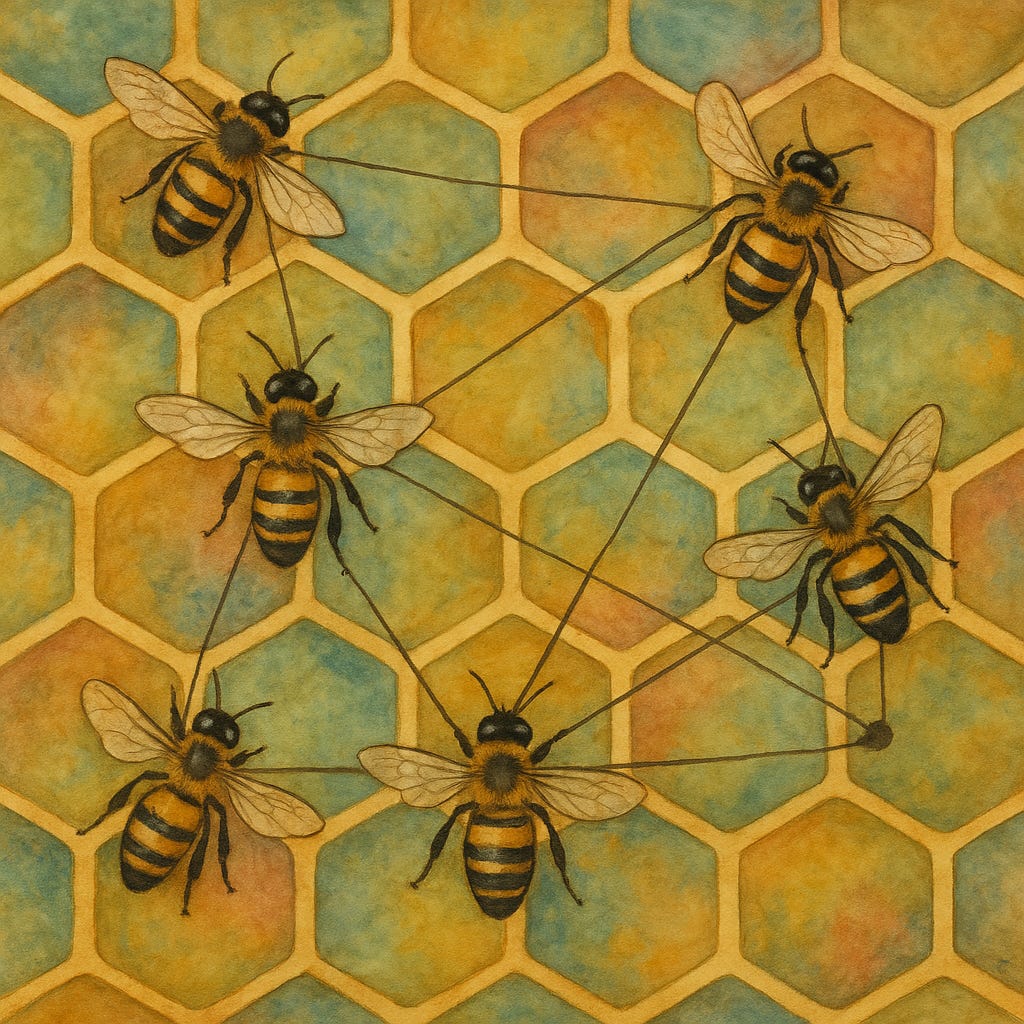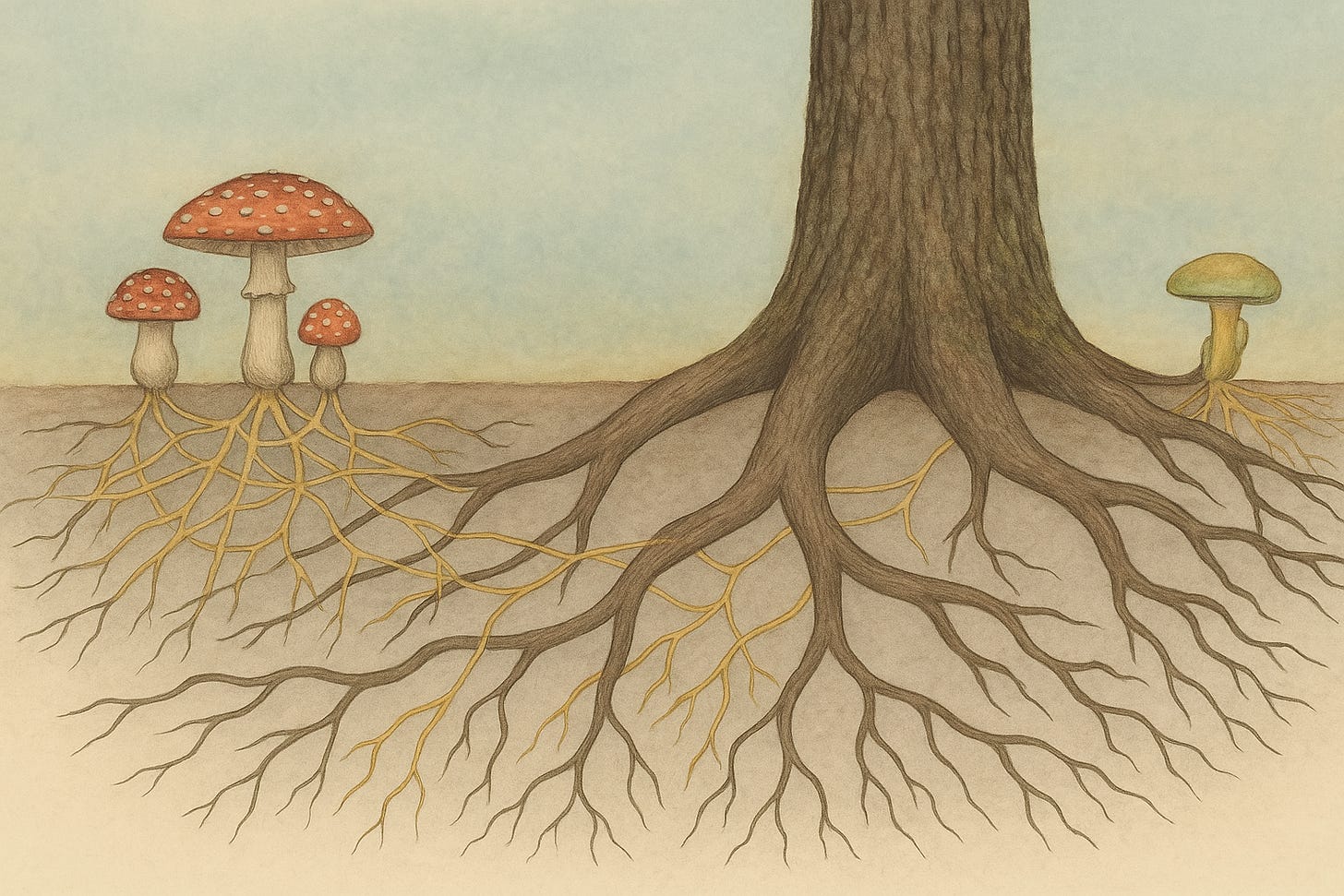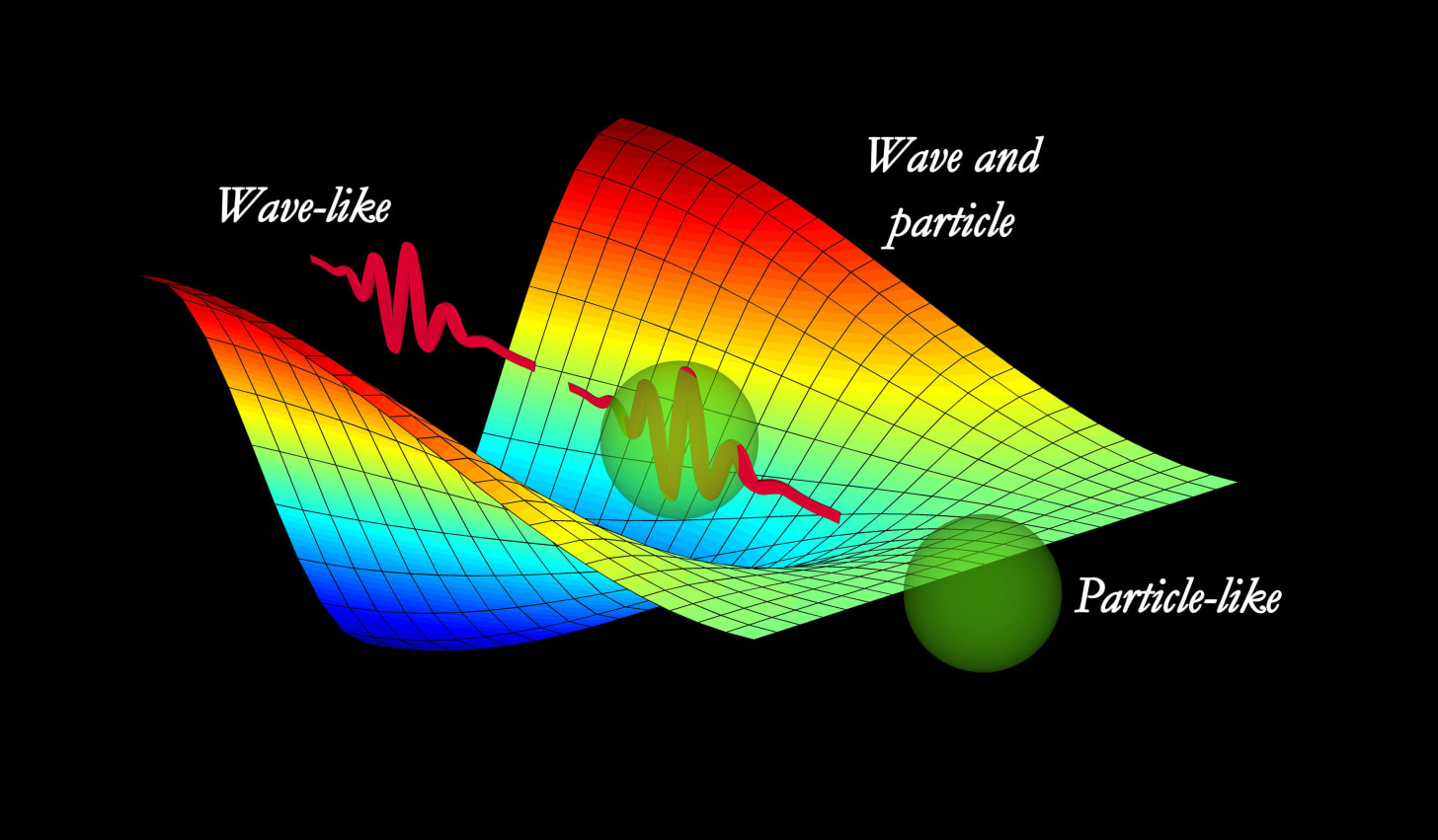Beyond the Divide: Part 2
Everything is connected, all of it. Fears are connected to failures that were connected to attempts that originated from a belief.
I’m here to explore what it means to integrate the mind, body, and soul. We will reflect on history, spirit, and wandering thoughts that all collide to give you the tools and insights you need to start living The Vitruvian Life.
Today’s topic is connected to the last article on connection. I will present to you examples of disconnection, connection, and how we can thrive by grasping duality and integrating it into our lives.
let’s get into it.
The Vitruvian Life is a reader-supported publication. To receive new posts and support my work, consider becoming a free subscriber.
We often hear about the butterfly effect.
The idea that the smallest flap of wings can alter the course of a storm halfway across the world. But what if we shifted our gaze to something more understood and compounded effects studied?
Call it the Bee Effect1.
Where the butterfly symbolizes chaos and mystery, the bee is a living thread in the web of life that we can easily visualize. It connects the farm to forest, and soil to society. It works constantly to weave systems together: ecological, agricultural, economic, etc.
Bees are tiny agents of connection
We too are part of something vast and interwoven. We forget this, but the forgetting doesn’t make it less true. The modern world often feels fragmented, but beneath the noise, a deeper truth hums:
Nothing exists in isolation. All things touch, affect, and rely on one another.
Examples of Disconnection / Fragmentation
We live in an age of hyper-connection.
So why do so many of us feel alone?
Social Media:
Social media has fragmented us, but not really.
In reality, it has brought us closer to each other by allowing us to interact with people all around the world. The fragmenting effect it has had is not literal but lives in our minds and heads. We still connect with people in real life and on top of that we get to connect with people online.
The fragmenting aspect of social media is purely a perceptual distortion that it causes, making us feel that we are more connected to people than we actually are.
So when we see people doing better than us or see a fight happen on the streets we feel that we are connected to that event making us feel an emotional withdrawal at a global level that we would never experience in real life. When the screen is turned on we feel connected to all of these events and people, and when we turn off the screen we feel as if we have been shut off from the world, that we have been unplugged.
But as I just said, this is folly on our part, our perceptions have been distorted and morphed.
Screen on or off, we are connected to all things, and we can build up our understanding of that perception online or offline. What you want to avoid, is falling too much into the connection that you experience online, just like how you don’t cry over the farewell of a stranger you meet at the bar. You should treat online encounters with even less empathy, but for some reason, our natural impulses reject this.
Cursive vs. Typescript:
When I was in school I hated cursive. Now I believe that my lack of cursive writing has led me to be less connected with my work.
When I write in cursive, I experience every letter in a word as an interconnected organism creating a tuned melody. In modern typescript, every letter in a word is disconnected and seemingly unassociated with every other one. Similarly, surfers prefer a smooth, developing wave, rather than a splashing, crashing wave.
Ideological Warfare:
If you were to waste your time watching or reading the news you would hear phrases like “The world has never been more polarized” or “We are more ideologically divided than ever” or even better “We live in unprecedented times”.
Remember the phrase we learned as kids “Sticks and stones may break my bones but words will never hurt me”.
Even if we are divided, the division lives in our minds. I feel a lot safer living in these “unprecedented ideologically divided times” than I would if I were alive during World War II or any other time before that. The job of the news is to create division and hide you from observing the obvious truth that we live in the most connected, safe, and exciting time in the history of mankind.
Examples of Connection
Let’s return to the bee and beyond.
Nature’s Web
Bees pollinate flowers. Flowers feed animals. Animals fertilize the soil. Soil grows food. Food feeds us. Humans are: thinking, feeling, and dreaming beings. This chain of life is not poetic but a literal representation of the way our world works. Similarly, mycelial networks2 communicate across forests, share nutrients, and warn others of threats.
Nature is just another word for connection. That is why when we feel connected to something or it makes us feel good we call it “natural”.
The Brain & Heart
In neuroscience, mirror neurons3 fire when they see others act, feel, and express. We’re wired to reflect each other. Empathy is not merely a biological idea, it’s a natural expression of our connection to all things. We are mirrors, tuned to recognize the dance in each other’s eyes.
Fall in love with someone, look up to them, or admire them and you will find yourself copying their actions. Why? Because you wish to feel connected to them.
Spiritual Threads
In Sufi mysticism, losing oneself in the divine is the only way to truly find yourself. In Buddhism, the principle of dependent origination4 says nothing arises independently; everything comes into being in relation to everything else. John 1:1 says “In the beginning was the Word, and the Word was with God, and the Word was God”. In Indigenous cosmologies, land, people, and spirit are not separate; they are one organism, breathing together.
All Spiritual paths come to the same conclusion: the human is connected to everything and everything is connected to the human.
Moments of Real Connection
You’ve felt it. In a deep conversation. A shared silence. Music that brings strangers into sync. These are glimpses of wholeness.
Reminding us that the illusion of separateness and disconnection is just that: an illusion.
Duality: A Necessary Dance
Duality is constantly blending all around us.
Our perceptions are in constant flux.
Our understanding is always growing or shrinking.
In this life, you cannot escape the law of duality.
Understand duality and you will understand the world.
Life moves in opposites. Light and dark. Silence and sound. Self and other. We often try to choose one and reject the other, but true understanding comes from holding both and superpositioning your perception5.
Just like how light can be a particle and a wave at the same time, the human holds multiple personalities and identities.
Perception in Flux
Our minds are shaped by contrast. We understand joy because we’ve known sorrow. We value connection because we’ve felt loneliness. There is no awareness without differentiation.
Yin and Yang
Duality creates a dynamic balance that is necessary for life. In Eastern thought, yin and yang don’t oppose each other, they complete each other. Duality manifests itself everywhere: masculine and feminine, action and stillness, structure and flow, the wave and the ocean.
Alan Watts said it well:
“You are a function of what the whole universe is doing, in the same way that a wave is a function of what the whole ocean is doing.”
You’re not separate, you’re an expression of the whole. You are unique but never isolated.
Conclusion: Practicing Connection
At the heart of The Vitruvian Life is not perfection, but alignment.
The Vitruvian Man stands with arms outstretched, touching the circle and the square. A human being, poised between heaven and earth, thought and flesh, cosmos and self.
At its core, it is a symbol of wholeness.
To be whole does not mean that you have to have everything figured out. It means remembering that nothing is separate. Fears are connected to failures that were connected to attempts that originated from a belief. It’s all connected.
Call to Action: Live Like the Bee
So what do we do with this?
We practice.
Practice seeing the SELF in others.
Practice listening like every word matters
Practice breathing like it's your first inhale.
Practice creating like your hands were touched by the gods.
Let the bee be your guide. Pollinate the lives of others by playing your part in this vast network of life.
And ask yourself:
What would your life look like if you stopped identifying as a separate wave and started living as the ocean?
The journey towards a unified world starts from within.
Thank you for reading.
May your eyes be bright and full of everlasting laughter.
My X account if you are looking to partake in deep, sensitive, and bright conversations. All it takes is 1 sentence to change your paradigm.
The article "Why bees are critical for achieving sustainable development" explores the multifaceted contributions of bees to the United Nations' Sustainable Development Goals (SDGs), emphasizing their integral role in fostering interconnectedness between human well-being and environmental health. Beyond their well-known function in pollinating crops and supporting food security (SDG 2), bees enhance biodiversity by pollinating wild flora (SDG 15), contribute to economic growth through products like honey and wax (SDG 8), and inspire technological innovations (SDG 9). Beekeeping offers livelihood diversification, promoting poverty alleviation (SDG 1) and gender equality (SDG 5) by providing opportunities for women and marginalized communities. Additionally, bees aid in environmental monitoring, serving as indicators of ecosystem health (SDG 13). The authors advocate for a holistic approach to conservation that recognizes the intricate interdependencies between bees, people, and the planet, highlighting that safeguarding bee populations is essential for achieving a broad spectrum of sustainable development objectives.
When most of us think of fungus, we imagine mushrooms sprouting out of the ground. Those mushrooms are in fact the “fruit” of the fungus, while the majority of the fungal organism lives in the soil interwoven with tree roots as a vast network of mycelium. Mycelium are incredibly tiny “threads” of the greater fungal organism that wrap around or bore into tree roots. Taken together, myecelium composes what’s called a “mycorrhizal network,” which connects individual plants together to transfer water, nitrogen, carbon and other minerals. German forester Peter Wohlleben dubbed this network the “woodwide web,” as it is through the mycelium that trees “communicate”. - Britt Holewinski
In humans, mirror neurons are found primarily in the premotor cortex and inferior parietal lobule, activating both when we perform an action and when we observe someone else doing it, effectively linking perception and action in the brain. These neurons are believed to play a key role in empathy, language development, and social cognition by allowing us to intuitively understand others' emotions, intentions, and behaviors without conscious reasoning. Studies using fMRI have shown that mirror neuron systems respond not only to observed physical actions but also to facial expressions and emotional cues, suggesting their involvement in everything from learning by imitation to the contagious nature of emotions.
Dependent origination is the principle that all things arise through relationships—nothing exists on its own, but only in dependence upon other conditions. It reveals a vast web of interconnection, where every phenomenon—thoughts, emotions, identities, even time and space—is part of a dynamic flow, co-arising with everything else. Rather than viewing the world as made of separate, solid things, dependent origination invites us to see reality as a living system of causes and conditions, where change in one part ripples through the whole, and where the illusion of separateness gives way to an understanding of radical interdependence.
The article titled "Quantum Mystery of Light Revealed by New Experiment," published on Live Science on November 5, 2012, discusses a groundbreaking experiment that observed light exhibiting both particle-like and wave-like behaviors simultaneously. Historically, experiments demonstrated light acting either as particles or as waves, but not both at once. This experiment employed a novel measurement apparatus leveraging quantum nonlocality; a phenomenon where a particle can appear in two places at once to detect the dual behaviors concurrently. The findings provide deeper insights into the fundamental nature of light and contribute to our understanding of quantum mechanics.







